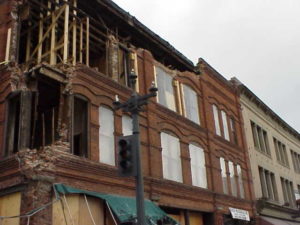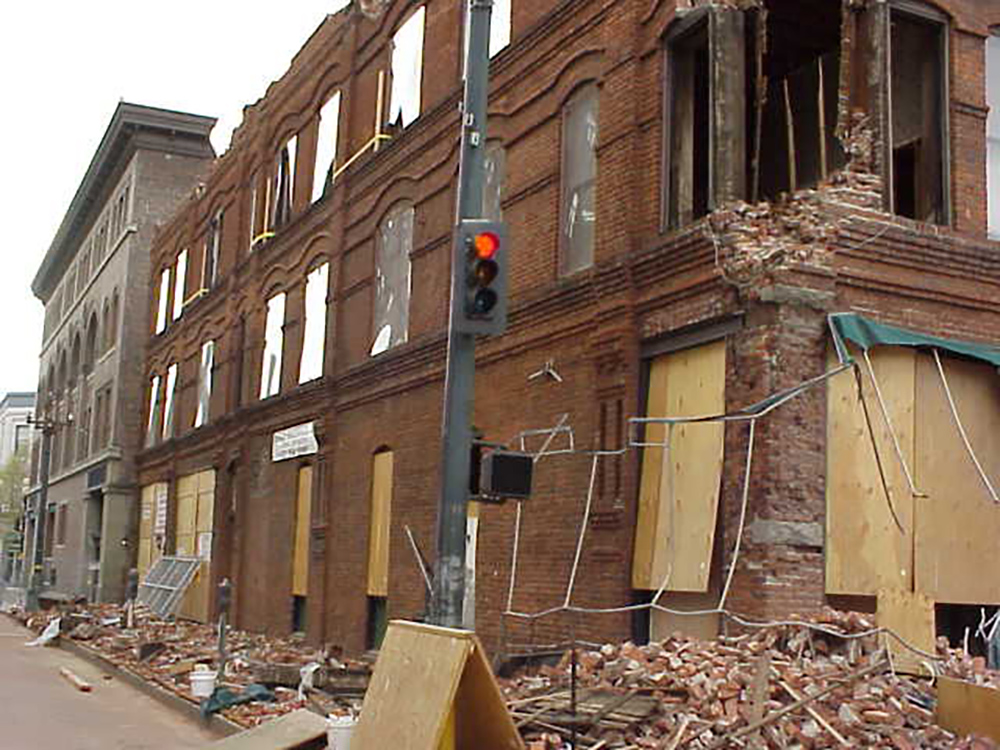View of the south side of Seattle’s Cascadia Hotel after the 2001 Nisqually Earthquake.
How do you perform long-needed safety improvements to an older building during tough economic times without upsetting those who depend on it and without sacrificing or compromising the charm of the building? There is an expression that if you try to satisfy everyone, in the end, you satisfy no one. I don’t subscribe to that point of view, and I have observed that the City of Seattle doesn’t either.

Earthquakes, such as the ones the Pacific Northwest has had in the past and will likely have in the future, do a fair bit of damage to buildings, especially brick buildings built before World War II. Those brick buildings typically have brick walls that support the building’s floors and roof. They are commonly referred to as unreinforced masonry (URM) buildings because they do not have any steel reinforcement in the walls to help resist wind and earthquake loads. URM buildings are some of the most susceptible to earthquake damage and have been responsible for many injuries and deaths around the world as a result of the bricks shedding from the structure and even collapsing walls.
To improve the seismic performance and reduce the risk of URM buildings harming occupants or bystanders, structural retrofits are usually needed. This includes connecting the floor diaphragms (the sheathing or “skin” covering the roof and floor framing) to the walls so that the walls and diaphragm work together to resist the seismic forces. The connections usually take the form of new steel rods solidly anchored into the wall and bolted to the wood floor or roof framing. This reduces the chance that the wall will move away from the floor, collapse, and harm people. This also helps the floor and roof stay up, because they remain firmly connected to the walls that support them.
The City of Seattle has over 800 URM buildings, some of which have not been retrofitted and appear to be potentially hazardous during a future earthquake. The City is looking to preserve existing URM buildings while also reducing the number that are poor-performing and un-retrofitted. The challenge is balancing the needs of public safety, the owners’ financial liability, City workload (of staff reviewing the proposed retrofits and providing permits for the work), and preserving the historical characteristics of the buildings.
At URM community meetings, the public’s focus is on public safety and minimizing damage. However, some URM building owners have concerns about mandatory retrofits; that the money to pay for the retrofit will be used for the benefit of the public without seeing a significant return. The owner would be required to pay this potentially unfunded mandate.
The organization dedicated to preserving Seattle and King County’s architectural legacy (Historic Seattle) is proposing to make the review process easier on URM building owners by developing a customized approach that allows owners to coordinate with a single person (instead of the entire board) if the retrofit work is basic and non-disruptive. Attaching the brick walls to the floors and roof diaphragms is an example that meets these criteria. In a case like this, just one dedicated person would evaluate the proposed retrofit, removing some of the uncertainties and adding a level of consistency.
For the City’s part, I have observed them take into account many insightful factors in balancing all of these competing interests as they work to improve public safety before the next earthquake occurs. A few of these are:
- Acknowledging the 10-year real estate cycle over which properties typically are sold or tenants move out of the building space.
- Giving owners sufficient time to interface with the building department to get the permits and allowing the permits to be valid over enough years to do (and pay for) the work.
- Avoiding scope creep by instructing inspectors not to expect non-seismic upgrades.
- Providing mechanisms like co-ops to buy the current building, do the retrofit work, and give the current owners a way to mortgage the building back.
- Encouraging the building owners to do more than the minimum seismic retrofit work.
If the City continues to pursue the current path, it appears a balance will be struck, and the URM buildings’ risk to the public will be reduced. They just might be able to satisfy everyone.



Nice article Alan.